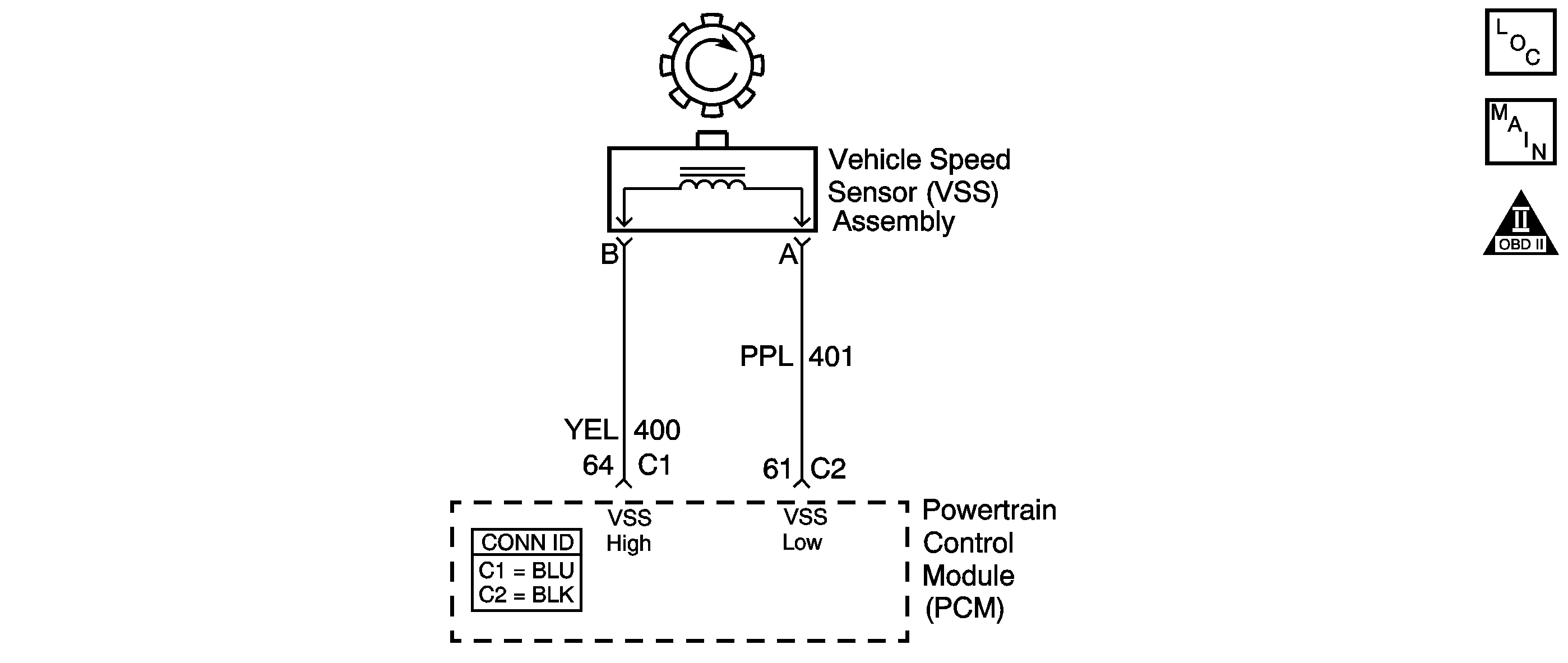
Circuit Description
Vehicle speed information is provided to the powertrain control module (PCM) by the vehicle speed sensor (VSS). The VSS is a permanent magnet generator that is mounted in the transaxle and produces a pulsing voltage whenever vehicle speed is over approximately 5 km/h (3 mph). The AC voltage level and the number of pulses increases with vehicle speed. The PCM converts the pulsing voltage into km/h (mph) and then supplies the necessary signal to the instrument panel for speedometer, odometer operation and to the cruise control module and multi-function alarm module operation.
Conditions for Running the DTC
| • | No manifold absolute pressure (MAP) sensor DTC P0107 or P0108. |
| • | No throttle position (TP) sensor DTC P0122 or P0123. |
| • | Engine speed is 1700-3600 RPM. |
| • | Throttle position (TP) is 0-1 percent. |
| • | Engine vacuum is 70-80 kPa (10-12 psi). |
| • | The above conditions are met for 5 seconds. |
Conditions for Setting the DTC
Vehicle speed is less than 3 km/h (2 mph).
Action Taken When the DTC Sets
| • | The PCM illuminates the malfunction indicator lamp (MIL). |
| • | The PCM disables Cruise Control. |
| • | The PCM commands the coolant fan ON. |
| • | The PCM records the operating conditions at the time when the Conditions for Setting the DTC are met. The PCM stores this information as Freeze Frame and Failure Records. |
| • | The PCM stores P0502 in PCM history. |
Conditions for Clearing the MIL/DTC
| • | The PCM turns OFF the MIL during the third consecutive trip in which the diagnostic runs and passes. |
| • | The PCM cancels the DTC default actions when the fault no longer exists and the DTC passes. |
| • | The PCM clears the DTC from PCM history if the vehicle completes 40 warm-up cycles without an emission-related diagnostic fault occurring. |
| • | A scan tool can clear the MIL/DTC. |
Diagnostic Aids
Ensure the VSS is correctly torqued to the transmission housing.
Test Description
The numbers below refer to the step numbers on the diagnostic table.
-
The resistance measurement will not change if either the VSS high signal circuit or the VSS low signal circuit, but not both, is shorted to ground. The vehicle speed detector in the PCM and the VSS are matched in such a way that an open or a short to ground in the VSS low signal circuit will not usually cause a loss of speed signal or a DTC P0502 to set.
-
This step isolates the short between the VSS and the wiring.
-
Do not skip Step 7. The J 39200 digital multimeter (DMM) will detect AC voltage if the VSS high signal circuit is shorted to ground.
-
The replacement PCM must be programmed and the crankshaft position system variation procedure must be performed. Refer to the latest Techline procedures for PCM reprogramming and to Crankshaft Position System Variation Learn in Engine Controls 2.4 L.
Step | Action | Value(s) | Yes | No | ||||||||
|---|---|---|---|---|---|---|---|---|---|---|---|---|
1 | Did you perform the Powertrain Diagnostic System Check? | -- | ||||||||||
2 |
Notice: In order to avoid damage to the drive axles, support the lower control arms in the normal horizontal position. Do not run the vehicle in gear with the wheels hanging down at full travel. Important: Record the Failure Records before clearing the DTCs. Using the Clear Info function erases the Failure Records from the PCM. Does the scan tool display vehicle speed above the specified value? | 0 mph | ||||||||||
3 |
Does the scan tool display vehicle speed above the specified value? | 0 mph | Go to Intermittent Conditions | |||||||||
4 |
Did the PCM require a calibration update? | -- | ||||||||||
Is the resistance within the specified range? | 530-870 ohms | |||||||||||
6 | Test the VSS high signal and VSS low signal circuits for the following conditions:
Refer to Circuit Testing in Wiring Systems. Did you find and correct a condition? | -- | ||||||||||
7 | Measure the resistance between the terminal C1 64 and ground. Is the resistance greater than the specified value? | 50 K ohms | ||||||||||
Is the resistance greater than the specified value? | 50 K ohms | |||||||||||
9 | Repair the short to ground in the VSS high signal circuit. Did you complete the repair? | -- | -- | |||||||||
Is the AC voltage equal to or greater than the specified value? | 0.5 V | |||||||||||
11 |
Did you find and correct a condition? | -- | ||||||||||
12 | Replace the VSS. Did you complete the repair? | -- | -- | |||||||||
Replace the PCM. Refer to Powertrain Control Module Replacement in Engine Controls. Is the action complete? | -- | -- | ||||||||||
14 |
Does the scan tool indicate that this diagnostic has ran and passed? | -- | System OK |
